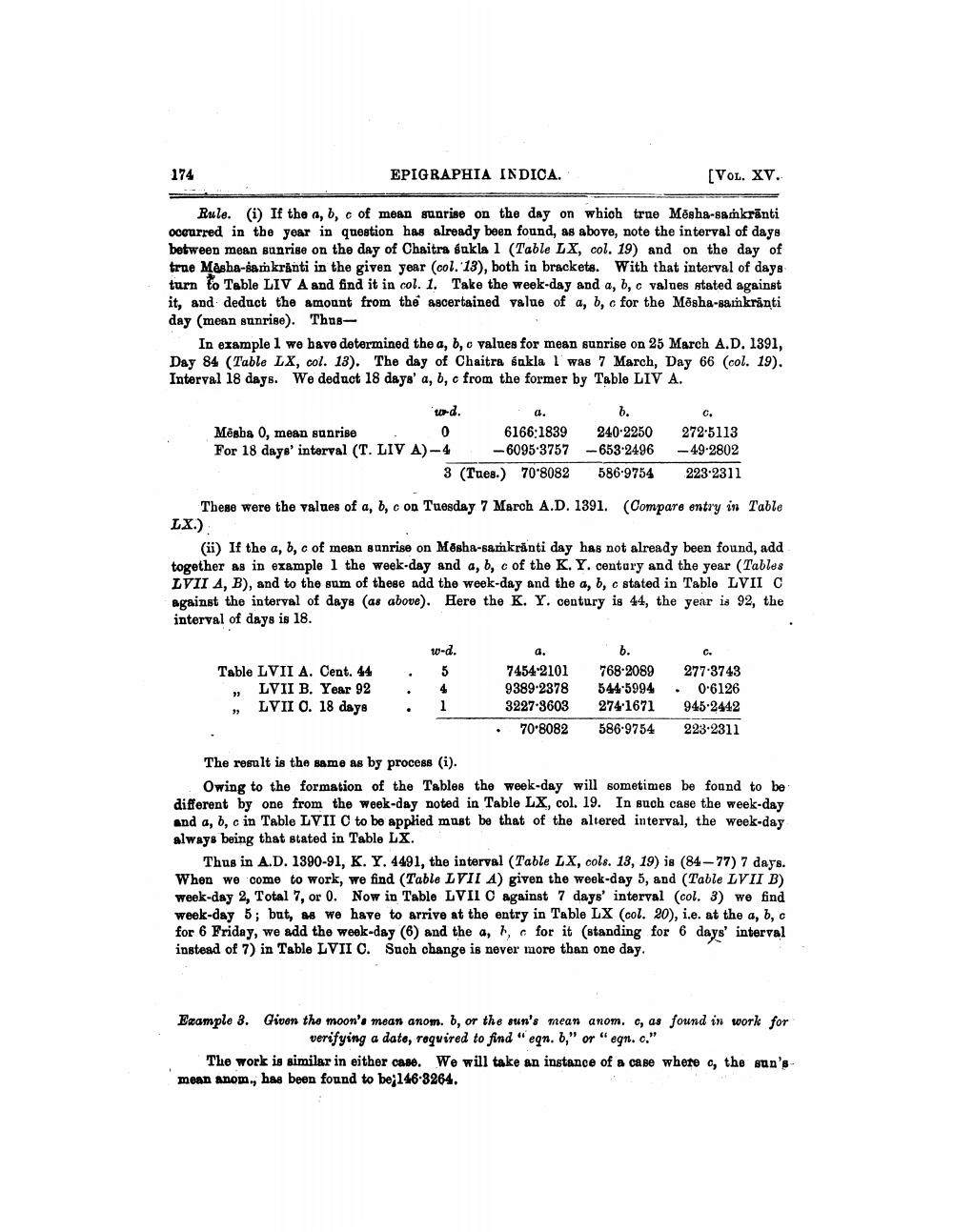________________
174
EPIGRAPHIA INDICA.
[Vol. XV.
Rule. (i) If the a, b, c of mean sunrise on the day on which true Mēsha-samkrānti occurred in the year in question has already been found, as above, note the interval of days between mean sunrise on the day of Chaitra sakla 1 (Table LX, col. 19) and on the day of true Masha-samkranti in the given year (col. 13), both in brackets. With that interval of days turn to Table LIV A and find it in col. 1. Take the week-day and a, b, c values stated against it, and deduct the amount from the ascertained value of a, b, c for the Mēsha-samkranti day (mean sunrise). Thus
In example 1 we have determined the a, b, c values for mean sunrise on 25 March A.D. 1391, Day 84 (Table LX, col. 13). The day of Chaitra sukla l was 7 March, Day 66 (col. 19). Interval 18 days. We deduct 18 days' a, b, c from the former by Table LIV A.
wd.
a.
b. Mēsba 0, mean sunrise
0
6 166-1839 240 2250 2725113 For 18 days' interval (T. LIV A)-4 -6095-3757 -653.2496 - 49-2802
3 (Tues.) 70-8082 5869754 223-2311 These were the values of a, b, c on Tuesday 7 March A.D. 1391. (Compare entry in Table LX.)
(ii) If the a, b, c of mean sunrise on Mosha-samkranti day has not already been found, add together as in example 1 the week-day and a, b, c of the K. Y. century and the year (Tables LVII A, B), and to the sum of these add the week-day and the a, b, c stated in Table LVII C against the interval of days (as above). Here the K. Y. century is 44, the year is 92, the interval of days is 18.
Table LVII A. Cent. 44 ., LVII B. Year 92 , LVII O. 18 days
. . .
w-d.
5 4 1
7454-2101 9389-2378
3227-3603 • 70-8082
768 2089 544-5994 274.1671 586-9754
277-3743 . 0.6126
945-2442 223.2311
The result is the same as by process (i).
Owing to the formation of the Tables the week-day will sometimes be found to be different by one from the week-day noted in Table LX, col. 19. In such case the week-day and a, b, c in Table LVII C to be applied must be that of the altered interval, the week-day always being that stated in Table LX.
Thus in A.D. 1390-91, K. Y. 4491, the interval (Table LX, cols. 13, 19) is (84-77) 7 days. When we come to work, we find (Table LVII A given the week-day 5, and (Table LVII B) week-day 2, Total 7, or 0. Now in Table LVII C against 7 days' interval (col. 3) we find week-day 5; but, as we have to arrive at the entry in Table LX (col. 20), i.e. at the a, b, c for 6 Friday, we add the week-day (6) and the a, b, c for it (standing for 6 days' interval instead of 7) in Table LVII C. Such change is never more than one day.
Example 3. Given the moon's mean anom. b, or the sun's mean anom. c, as found in work for
verifying a dato, required to find "egn. 6," or "egn. c." The work is similar in either case. We will take an instance of a case whete e, the sun's mean anom., has been found to be;146-3264.




